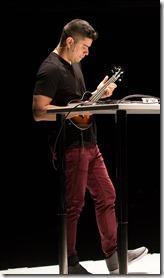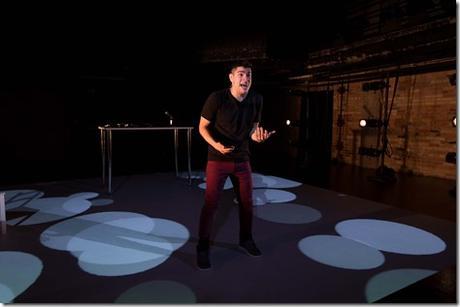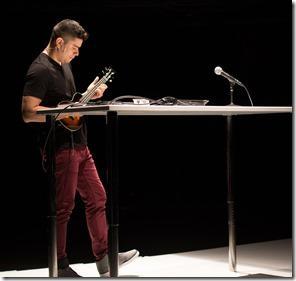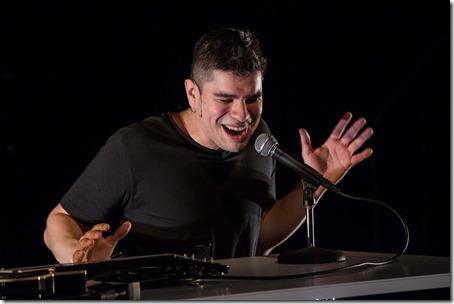

Every so often a movie, a book, or a play like this one comes along and is so timely and focused on the world, and particularly the United States, that it engenders a "must see" command from a reviewer. Brian Quijada has written such a play. He is also the sole performer and firmly holds the audience through 90 minutes of his life story, a story that might be told by millions of Latinos had they had the power to speak. Two years in the making, his tale begins in the womb as he tells of his family genealogy, his pride in his forbears and particularly his mother and father with whom he is to relate in different ways over his 25 years. To help us see his life, the life of many Latinos, he has creatively brought an assortment of electronics, a computer, a small microphone and a

The title of the play is derived from an experience he tells us about when he was in 3rd grade. It's Black History Month and his teacher is reciting some of the highlights of the Black experience, the slave trade, the servitude in the cotton fields, the Emancipation Proclamation, the renewed repression and finally into the Civil Rights Era which was fomented by Rosa Parks and her front-of-the-bus seat selection. Brian, the 3rd grader, is awed by the story, then a question develops in his 3rd grade mind. Slowly, he raises his hand. The teachers says "Yes, Brian?" and Brian asks, "Where did 'we' sit on the bus?" A long pause ensues, the teacher apparently in thought, who finally replies, "You weren't there." Brian is stunned! "Not there?" And so begins his search to find exactly where he, as a Latino, is. He proceeds to take us through his school years, some in Highwood, Il., heavily Latino, and then later into Highland Park IL, heavily white and Jewish. On one hand he makes friends in his new school but also incurs the rancor of his Latino friends because they see him preferring whites to their company. More confusion for Brian. Is it not possible to have friends of differing skin colors?
While all this is going on, he finds he has a gift for, and a joy in, theater. But his father gives him no support, telling him that he needs to study science or engineering so he'll make a good living, not wasting time on the stage. Brian persists, lands a role in the school play and the night of the production for friends and family, he scours the audience to find his parents. Sadly, they're not there to support him. He persists in his chosen vocation however, enjoying it but missing his parents' blessing. On one occasion, his class takes a school trip to New York. Brian is thrilled beyond belief. Just being in Times Square, seeing all the theater marquees delights his soul. Then they take a tour to Ellis Island where his classmates can check the roster to see from where their forbears emigrated - but Brian realizes that his ancestors came over the border from Mexico and they're not in the book. Excluded again. He also remembers seeing a photo on TV of Latino kids lying on a beach, using their bodies to form the word "Dream", a reference to the Dream Act allowing Latino students who graduated college to gain a path to citizenship - which never made it through Congress. And several times he alludes to the fact that his father is undocumented, an "illegal".
Brian persists in his own dream to become a performer, continuing his schooling but working in theaters wherever he can. And one night, one magic night, he finds his parents in the audience giving him the support he so fervently wished for. Then, to complete his young life, he marries a woman of Swiss and German descent, telling her that if they had to ride on a bus in the early days, she'd be in the front of the bus and he'd be in the back. When he learns his wife is pregnant, he talks about how he's going to tell his child about his roots and when he's old enough, they'll buy a bus and they'll drive off and pick up everybody! And everybody can sit where they want. That would be a world worth living in.
So much went into this presentation that added to the impact of the performance. The lighting design by Diane Fairchild, the video projections design by Liviu Pasare, Andrei Onegin's scenic design; the graphic design by Angelica Acebedo-Frint - all add depth and smoothness to the flow of the dialogue. And it was our good fortune to speak with the Director, , who talked about meeting Brian in Denver several years ago and saw him perform, whereby they formed a bond to fully develop the material we saw opening night. Partnerships come to fruition and this one brought entertainment and thought provoking dialogue to an attentive audience that I hope will be repeated through the entire run. This would also be a great play for school students to help them understand the world a little better and, perhaps, differently.
Where Did We Sit on the Bus? continues through Aoril 10th at DCASE Storefront Theater, 66 E. Randolph (map), with performances Thursdays-Saturdays at 7:30pm, Sundays 3pm. Tickets are $15 (seniors/students: $12), and are available online through Tix.com (check for half-price tickets at Goldstar.com ). More information at TeatroVista.org/Bus. (Running time: 90 minutes without intermission)

behind the scenes
Tags: 16-0337, Andrei Onegin, Angelica Acebedo-Frint, Brian Quijada, Chay Yew, Chicago Theater, DCASE Storefront, DCASE Storefront Theater, Diane Fairchild, Duane Barnes, Joel Maisonet, Liviu Pasare, post, Teatro Vista
Category: 2016 Reviews, DCA Theatre, Duane Barnes, One-Man Show, Storefront Theatre, Teatro Vista, Video, YouTube

